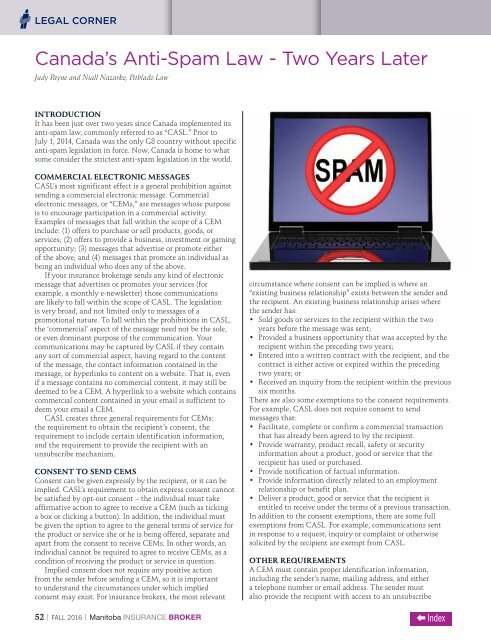You also want an ePaper? Increase the reach of your titles
YUMPU automatically turns print PDFs into web optimized ePapers that Google loves.
LEGAL CORNER<br />
Canada’s Anti-Spam Law - Two Years Later<br />
Judy Payne and Niall Nazarko, Pitblado Law<br />
INTRODUCTION<br />
It has been just over two years since Canada implemented its<br />
anti-spam law, commonly referred to as “CASL.” Prior to<br />
July 1, 2014, Canada was the only G8 country without specific<br />
anti-spam legislation in force. Now, Canada is home to what<br />
some consider the strictest anti-spam legislation in the world.<br />
COMMERCIAL ELECTRONIC MESSAGES<br />
CASL’s most significant effect is a general prohibition against<br />
sending a commercial electronic message. Commercial<br />
electronic messages, or “CEMs,” are messages whose purpose<br />
is to encourage participation in a commercial activity.<br />
Examples of messages that fall within the scope of a CEM<br />
include: (1) offers to purchase or sell products, goods, or<br />
services; (2) offers to provide a business, investment or gaming<br />
opportunity; (3) messages that advertise or promote either<br />
of the above; and (4) messages that promote an individual as<br />
being an individual who does any of the above.<br />
If your insurance brokerage sends any kind of electronic<br />
message that advertises or promotes your services (for<br />
example, a monthly e-newsletter) those communications<br />
are likely to fall within the scope of CASL. The legislation<br />
is very broad, and not limited only to messages of a<br />
promotional nature. To fall within the prohibitions in CASL,<br />
the ‘commercial’ aspect of the message need not be the sole,<br />
or even dominant purpose of the communication. Your<br />
communications may be captured by CASL if they contain<br />
any sort of commercial aspect, having regard to the content<br />
of the message, the contact information contained in the<br />
message, or hyperlinks to content on a website. That is, even<br />
if a message contains no commercial content, it may still be<br />
deemed to be a CEM. A hyperlink to a website which contains<br />
commercial content contained in your email is sufficient to<br />
deem your email a CEM.<br />
CASL creates three general requirements for CEMs:<br />
the requirement to obtain the recipient’s consent, the<br />
requirement to include certain identification information,<br />
and the requirement to provide the recipient with an<br />
unsubscribe mechanism.<br />
CONSENT TO SEND CEMS<br />
Consent can be given expressly by the recipient, or it can be<br />
implied. CASL’s requirement to obtain express consent cannot<br />
be satisfied by opt-out consent – the individual must take<br />
affirmative action to agree to receive a CEM (such as ticking<br />
a box or clicking a button). In addition, the individual must<br />
be given the option to agree to the general terms of service for<br />
the product or service she or he is being offered, separate and<br />
apart from the consent to receive CEMs. In other words, an<br />
individual cannot be required to agree to receive CEMs, as a<br />
condition of receiving the product or service in question.<br />
Implied consent does not require any positive action<br />
from the sender before sending a CEM, so it is important<br />
to understand the circumstances under which implied<br />
consent may exist. For insurance brokers, the most relevant<br />
circumstance where consent can be implied is where an<br />
“existing business relationship” exists between the sender and<br />
the recipient. An existing business relationship arises where<br />
the sender has:<br />
• Sold goods or services to the recipient within the two<br />
years before the message was sent;<br />
• Provided a business opportunity that was accepted by the<br />
recipient within the preceding two years;<br />
• Entered into a written contract with the recipient, and the<br />
contract is either active or expired within the preceding<br />
two years; or<br />
• Received an inquiry from the recipient within the previous<br />
six months.<br />
There are also some exemptions to the consent requirements.<br />
For example, CASL does not require consent to send<br />
messages that:<br />
• Facilitate, complete or confirm a commercial transaction<br />
that has already been agreed to by the recipient.<br />
• Provide warranty, product recall, safety or security<br />
information about a product, good or service that the<br />
recipient has used or purchased.<br />
• Provide notification of factual information.<br />
• Provide information directly related to an employment<br />
relationship or benefit plan.<br />
• Deliver a product, good or service that the recipient is<br />
entitled to receive under the terms of a previous transaction.<br />
In addition to the consent exemptions, there are some full<br />
exemptions from CASL. For example, communications sent<br />
in response to a request, inquiry or complaint or otherwise<br />
solicited by the recipient are exempt from CASL.<br />
OTHER REQUIREMENTS<br />
A CEM must contain proper identification information,<br />
including the sender’s name, mailing address, and either<br />
a telephone number or email address. The sender must<br />
also provide the recipient with access to an unsubscribe<br />
52 | FALL 2016 | Manitoba INSURANCE <strong>BROKER</strong> Index


